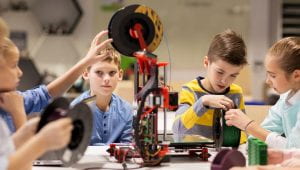Apr
2019
The Focus of PBL (Project Based Learning)
 In a traditional learning environment, foundational content is presented by the teacher, digested by the students, and restated to the teacher by the students.
In a traditional learning environment, foundational content is presented by the teacher, digested by the students, and restated to the teacher by the students.
When students do not master that foundational content before they move on to the advanced concepts, they lose focus and purpose. They become strategic about ‘chasing points’ and performing just well enough to ‘not get hassled.’
Since most adolescents do not see the bigger picture of learning and engagement and are not intrinsically motivated by grades and points, the Project-Based Learning (PBL) model offers a way to maintain a high level of student engagement while assessing for mastery.
PBL is a comprehensive student-centered pedagogical approach to learning involving a dynamic classroom methodology. PBL is unlike traditional leaning because it does not move in lock-step with teacher directions. In traditional learning, students are presented with content by the teacher, the student, in turn, memorizes the provided content, and to demonstrate learning; the student offers the same content back to the teacher (i.e., standardized test).
In PBL, the teacher presents a problem or issue to be solved, the student identifies the key components, takes action based on identification, and to demonstrate learning, the student applies both prior knowledge and content knowledge to solve the problem.
In addition, PBL offers the unique feature of public presentation. Students present conclusions and solutions to the presented problem or issue publicly instead of in a silo of student-teacher communication. PBL’s design is distinctive because unlike traditional learning — which mainly focuses on linearly transmitting information, the PBL design focuses on deepening holistic understanding.
The instructional focus of PBL is student ownership. PBL affords students an opportunity to take ownership of their own learning as well as provide opportunities to collaborate with peers and solve practical problems utilizing a variety of tools such as data, research, and analysis. Further, there is an instructional focus on generating new and creative ideas, projects, and plans all while communicating and sharing solutions with real-world audiences publicly.
The PBL method also enables students to visualize the timeline of events and provides students with many avenues to ‘show what they know.’ By helping students visualize how events actually unfold, PBL enforces research, writing, discussions, and reflections that enforce problem-solving, critical thinking, and content application skills as final products for assessment.
The assessment focus of PBL is authentic assessment. Authentic assessment is a way for students to show they can use what they have learned in the real world. When students are given the option to produce a PBL assignment they are provided an opportunity to utilize all aspects of the standards-based grading model and demonstrate a depth of the level of mastery not found in any traditional test, however they still receive a traditional letter grade. Authentic assessments are interactive and have a substance that affects deeper and more holistic learning. Authentic assessment is where mastery of information means the content is internalized, connected, and learned.
The goal of PBL is to facilitate learning, foster self-directed learners, and craft critical thinking. The PBL Model also involves being a teacher-coach, letting go of preconceived notions of classroom responsibility, putting teacher control in check, and motivating students to uncover informational content with depth and breadth. PBL is more than a learning process; it is a human process, a social process, a process which produces indelible results.